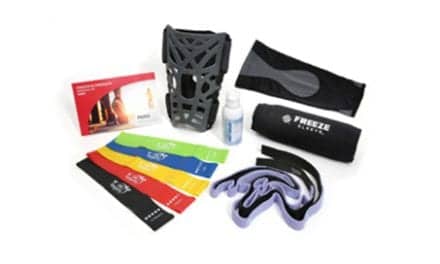By Dimitrios Kostopoulos, DPT, MD, PhD, DSc, ECS
For individuals who are active, the desire to be rehabbed quickly and return to fitness or sporting activities is very high. There is even more urgency for professional or semi-professional athletes who need to return to their sport and training activities quickly.
Therefore, not only is the accurate diagnosis of the specific injury or problem paramount, but it is equally important to identify on an ongoing basis the accurate progression and improvement that results from the physical therapy rehabilitation program.
To do this, physical therapists are increasingly bringing diagnostic testing into the clinic to troubleshoot issues with challenging patients quickly and accurately. This leads to better outcomes, with patients experiencing faster, more effective results.
Among the tests that physical therapists can be trained on include electromyography (EMG) nerve conduction testing and musculoskeletal and neuro ultrasound.
EMG/NCS Testing
EMG/NCS testing is one of the most reliable diagnostic tools for many dysfunctions of the Neuromuscular System. An EMG measures the electrical activity of muscles at rest and during contraction. Nerve Conduction Studies (NCS) measure the health of the nerves.
Physical therapists have been able to perform EMG and nerve conduction tests for more than 45 years. In 1978, the American Physical Therapy Association established a specialty program through the American Board of Physical Therapist Specialties for certification in clinical electrophysiology.
The other diagnostic technique is Musculoskeletal Ultrasound (MSKUS) imaging, which uses sound waves to produce pictures of muscles, tendons, ligaments and joints throughout the body. It is used to help diagnose sprains, strains, tears, and other soft tissue conditions and to guide therapeutic procedures.
Diagnostic ultrasound is a safe and noninvasive test that can provide real-time imaging, allowing for examinations of structures at rest and in motion. As a result, utilization of this diagnostic tool is rapidly becoming the standard of care for visualizing the musculoskeletal anatomy and evaluating and managing joint tissue disorders.
Diagnostic Ultrasound in PT Practice
Let’s take, for example, an athlete who has come into physical therapy with shoulder pain after sustaining an injury playing tennis or basketball. The physical therapist can utilize MSKUS technology and is able to identify the pathology in a dynamic fashion instead of using a still MRI image.
With MSKUS, the physical therapist can perform a variety of maneuvers of the patient’s shoulder to place the muscles and the tendons and ligaments in value-stressed positions. This allows the physical therapist to observe a dynamic image related to the behavior of these anatomical structures under stress.
Conditions such as very small rotator cuff tears that are not visible with still MRI imaging can be well visualized in a dynamic maneuver.
Research studies demonstrate that for shoulder pathology—specifically, MRI imaging and musculoskeletal ultrasound imaging—are equally effective.1
Another advantage to MSKUS is that it can be performed in a provider’s own clinic with access to immediate results, thus eliminating the need to send the patient to a different facility for an MRI.
MSKUS is also made to be ideal for re-testing patients as they progress in their treatment plan to identify improvement (or not) in the structure as the rehab progresses.
For example, in cases of tendinosis, the tendon thickens. By comparing the affected versus the non-affected side, we can evaluate the degree of thickening of that tendon and how that thickening changes with the proper rehab.
In cases of tendon tears, clinicians can see the disruption of tendinous fibers in the images to determine how, with the proper rehab, they can restore these fibers as the physical therapy program progresses.
In the fitness world, athletes often want to strengthen very specific parts muscles or parts of the body. MSKUS can provide visual feedback for specific muscle recruitment. In doing so, patients as well as physical therapists can make absolutely certain that the dynamic movement that the patient performs is recruiting the specific muscle that needs to be strengthened.
Training to Use MSKUS
Physical therapists have long sought more objective methods of diagnosis such as EMG and MSKUS to supplement the normal physical evaluation. Today, training programs such as Hands-On Diagnostics exist to reduce the learning curve and speed the time to reimbursement.
Hands-On Diagnostics is a national franchise organization created to help physical therapy practices establish in-house diagnostic services for their patients. To date, the franchise has expanded to 18 different states with more than 115 physical therapy facilities.
The program is supported by live and virtual mentorships with board-certified experts that allow the physical therapist to be able to perform these tests and get reimbursed almost immediately.
The ultimate goal of Hands-On Diagnostics is to provide a clear path for therapists to achieve board certification in clinical electrophysiology testing as well as certification in musculoskeletal ultrasound. Of the nine physical therapists certified in clinical electrophysiology in 2016, five were franchise members. Hands-On Diagnostics also has created a Fellowship program in Musculoskeletal Ultrasound Sonography.
By expediting the training in these techniques, clinics can expand the scope of their practice, while also deriving more effective treatment plans that improve the effectiveness of the patient’s rehabilitation program and speeding the return to fitness or sports activities.
Dimitrios Kostopoulos, DPT, MD, PhD, DSc, ECS, is ABPTS Board Certified in EMG/NCS Testing. For more information, contact [email protected].
Reference
1. de Jesus JO, Parker L, Frangos AJ, Nazarian LN. Accuracy of MRI, MR arthrography, and ultrasound in the diagnosis of rotator cuff tears: a meta-analysis. American Journal of Roentgenology. 2009;192(6):1701-1707.









It’s good to know that musculoskeletal ultrasound imaging is effective for shoulder pathology. My wife has been having a lot of shoulder pain. I’ll find a doctor that can help her and give her this type of ultrasound.